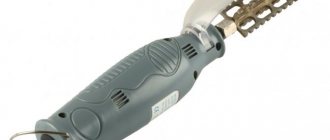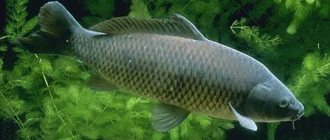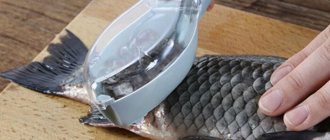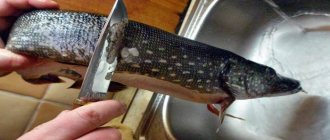Carp is a river fish that is rich in tasty, dense meat.
Such fish require a special approach to cleansing it of scales and bones. Before you start cleaning carp, you need to know some specific points. Although carp scales seem very dense, they must be handled very carefully. If you catch fish yourself, it is better to clean it immediately after catching. This will not affect the taste of the fish in any way, but it will save you some hassle.
After reading this article, you will learn how to peel carp scales with a spoon - review.
The benefits of carp for humans
Carp is a very tasty and healthy fish. It contains many vitamins and minerals: iodine, vitamin C, PP, B1, B2, B6, B12, as well as pantothenic acid, a lot of phosphorus, calcium, potassium, magnesium, iron, copper, zinc.
Regular consumption of carp leads to:
- improving memory and performance,
- reducing blood cholesterol levels;
- improving appetite;
- normalization of blood pressure;
- improving the functioning of the digestive system;
- cleansing the liver.
It is easily absorbed by the human body. Carp is a dietary product. It is recommended for consumption by adults and small children. The benefits of carp for human health have been proven by scientists. It does not accumulate radionuclides and heavy metals. Does not cause allergic reactions. Contains a large amount of polyunsaturated fats. Positively affects the cardiovascular system.
How to get rid of odor
Like many other river or pond fish, carp have a not very pleasant smell of mud. In principle, properly cut and prepared carp smells less, but the smell still remains. Especially when the fish is cooked with scales.
The easiest way to reduce the smell of mud is to sprinkle the carcass with lemon juice before cooking.
You can remove the smell of mud by pre-soaking the fish in milk half an hour to an hour before cooking. You can also add aromatic herbs and spices there.
Removes odor and ordinary table vinegar. To do this, add a tablespoon of vinegar to one liter of cold water and soak the fish in it for 2 hours. After soaking, rinse well and dry with a paper towel.
If you don’t have time to get rid of the smell by soaking the fish, just sprinkle the already cooked fish with a large amount of fresh dill.
Appearance
Characteristics:
- Thick body of moderate length.
- Large, uniform, cylindrical scales with a characteristic edging on the sides.
- The sides are brown or golden yellow.
- Double nostrils.
- He often pulls his mouth into a tube.
- Small mustache above the upper lip.
- The eyes are set high, the pupils are small.
- Dark back with characteristic gray-olive fins.
- In adult specimens, brownish, gray and dark gray tones predominate in the general color.
- There are individuals that have no scales. This variety is called naked carp.
Carp is a freshwater fish; it comes to the table either from the store or by catching it yourself from a reservoir. It can grow up to one and a half meters. This fish lives in rivers and lakes, and is found in ponds, reservoirs, and artificial reservoirs. It is almost impossible to find it in the ocean and in the sea. This is due to the fact that it is not able to live in salt water.
How to pull the gills out of a fish through its head. Why remove the gills from fish for soup? Gill removal process
But it turns out well at home, on the stove, in an ordinary pan. We disassemble the fish into bones and meat, which we then return to the fish soup. We will not need boiled vegetables, since they have already given all their taste and aroma to the broth. Cook at low boil for about 15-20 minutes, carefully skimming off the foam. Add the rest of the fish (or head) and bring to the boil again. Fish varieties that are distinguished by their tenderness, stickiness and some sweetness are suitable for fish soup.
Fish soup is the main fishing dish; it is often cooked on fishing trips and river trips. The main thing is to take good fish. Ukha is not just fish soup. More precisely, it is not fish soup at all. The soup is distinguished by a very small amount of vegetables, transparency and richness of the broth.
Although fish soup is made primarily from freshwater fish, sea fish can also be used. It is believed that you need at least 2 varieties of fish. But more than 4 is already too much. It is best to choose small and large fish. The fines will give a rich broth, and pieces of large fish will look beautiful in the broth. All fish must be gilled and gutted. It is also better not to clean small fish. Large fish must be cleaned and cut into large pieces. They are often called "links".
This is the most delicious soup; you don’t need anything else for it, except maybe an onion. You don’t even need spices, since live fish has a unique taste that does not need to be emphasized or softened. This is the name for fish broth, broth, or soup liquid. Yushka should be transparent and rich. Therefore, the fish is placed in cold water. The heads and tails are not removed (the gills must be cut out) - they add a rich taste. But the fins can be trimmed.
The best fish soup is with a light, transparent broth. In the old days they used a caviar guy. If you come across fish with caviar, you can lighten the broth according to old recipes. Cover the fish soup with a lid and cook over low heat for 15 minutes, then strain and bring to a boil again. It is added if the fish soup is cooked using small fish. Moreover, it improves the taste of the fish soup. Provided if the fish is fried immediately? I'm cutting. The fish I buy is lake fish, there is a lot of namul, which means there is a lot of debris in the gills.
How to choose the right carp in the store
When choosing fresh carp, pay attention to the following:
- Fresh carp meat may have the smell of river water, algae, or pond. It should be elastic.
- There cannot be a cloudy layer, mucus or blood on the skin.
- Gill covers - pink or red, not stuck together
- The eyes are clear, without a veil.
If you want to buy frozen fish, then you should pay attention to the quality of the glaze. It should be transparent, uniform and free of streaks. This suggests that the carcass was frozen on the day it was caught.
If, when purchasing a frozen carcass, you notice that its surface is rough, this indicates that the technology was violated at some stage of processing. It should be smooth.
If the carcass has spots or is brown in color, it is probably spoiled.
Why cut out the gills when cleaning fish?
Ruff, perch, pike perch and whitefish are best suited, a little less so are carp, asp, chub, carp, crucian carp, rudd. Other types of fish can also be used as a basis for fish soup, but it is better to use them as additional ones. It will not be possible to cook fish soup from some types of fish, since their meat does not have the necessary properties. These are gudgeon, bream, roach, bleak, roach, ram, sabrefish, mackerel, goby. Suitable sea fish for fish soup include grenadier, cod, halibut, vomer, sea bass, and squama, but it must also be fresh.
Preparing the site
Carp can be cleaned in the kitchen, but its scales will fly in different directions. Therefore, housewives suggest putting it in a basin or other suitable container. You will also need a large volume of water, you can use running water.
Prepare a sponge, but remember that after working with fish you will have to throw it away. You will also need towels or napkins to dry the carp after washing.
Knives, scissors, scrapers and other devices can be laid out on the workplace in advance.
You can also use the package. You need to place the fish in it and remove the scales. In this case, the kitchen will definitely remain clean.
Removing scales using the chain mail method
You can use this method to remove all the scales at once and not stain everything around.
Instructions:
- Place the carp on a cutting board. Take a sharp long knife.
- Use a knife to pry off the scales without damaging the skin.
- Move the knife towards the head, cutting off the scales.
- Having reached the head, where the scales connect to the bone, make an incision.
- Remove the scales, which will look like chain mail.
- Repeat the described manipulations on the other side of the fish.
Preparing carp for cleaning and cooking
Not every housewife knows how to properly clean carp. It is better to clean it fresh, in three stages:
- Preparation.
- Removing scales.
- Removal of internal organs.
Before you start cleaning and preparing carp, you need to perform several preparatory steps:
- If the fish is caught with bait, then you need to rinse your throat by directing a stream of water there. This is done to wash away all excess.
- It is necessary to remove the gills near the head. Because bacteria multiply most quickly in them. You can skip this step if you don't plan to use the head for cooking. If you don't need it, you can simply cut it off.
- The carcass must be washed very well, the fins must be cut off so that they do not interfere with the removal of scales.
Removing fins
The fins can be cut with scissors, but it is better to remove them completely with a knife.
Instructions:
- Make cuts on the sides of the ridge.
- Gently pull it towards you and continue making slits until it is completely separated from the carcass.
- You can try to pull out the fins on the belly and near the head with your hands. If this does not work, then use a knife and make small cuts.
Be careful with the fins! They can seriously injure your hands.
Removing scales
This is the most difficult stage. It is best to clean fish from scales with a sharp knife. You need to be extremely careful during the process.
- Pour boiling water over the carp. This way we soften the scales.
- Let's start cleaning with a fillet knife from the tail to the head; if there are small scales left, just clean them off. We wash the knife periodically under the tap.
- Wash the carp with running water until the scales are completely removed.
The video shows a manual cleaning method that will ensure a clean kitchen.
The process of cleaning frozen fish is no different, but it should be slightly defrosted before working.
Carp should be soaked in water before cleaning. To give it a special taste, you can add dill or a little lemon zest.
Cleaning fresh carp from scales at home
The carp, whether it is a large mirror specimen covered with a small number of scales or an ordinary freshwater carp covered with a small scaly layer, needs to be cleaned before production. For the purpose of this process, you can take a regular knife. If the required skills are missing, the tool is not quite sharp. To avoid injuries and cuts, you can use a spoon or fork. To clean the carcass, they also use metal scrapers, which can be purchased at any hardware store, or a vegetable peeler with a long blade - with it the event will go faster and easier.
How to gut
Cleaned and washed carp must be properly gutted.
- We place the washed carp on a cutting board; you can put paper or a plastic bag on it.
- We make an incision from head to tail, rip open the belly.
- We carefully pull out the insides so that the bile does not burst, because in this case the meat will taste bitter.
- We wash the fish thoroughly.
To get rid of lingering odor, wipe your hands and board with lemon juice.
Cleaning Tools
Some housewives are faced with the question of how to clean and cut carp, and what tools should be used?
Basically, a regular knife or a special knife for removing scales is used to clean fish. But many craftsmen, when traveling, adapt a variety of objects for this purpose. Bottle caps, tin cans, glass shards, sticks, etc. are used.
Inexperienced housewives often use a spoon or fork. In this case, it is necessary to pry the scales with them and pick them out. This should be done from the head, moving towards the tail. Common small scrapers or vegetable peelers are often used as cleaning items. It is better to use scissors to remove fins.
How to cut
It all depends on how we cook the fish: whole or sliced, or perhaps you only need fillets.
In the first case, you need to remove the eyes and gills with fins and cut off the head and tail.
If you have to prepare portioned pieces, then cut the carcass as required by the recipe. You can fillet large fish by following the steps below.
How to fillet carp
You need a knife and a cutting board.
- Using a sharp knife, make an incision along the gills, reaching the spine.
- We make an incision from the dorsal fin.
- We cut through the tail part with a knife.
- Separate the meat. We leave the ribs on the ridge.
- After this, remove the fillet from both sides.
- Remove the skin from the fillet.
- We check for the presence of single bones. Ready!
Tips for choosing high quality carp
- A fresh carcass is easier to clean. If you buy fish in a store or market, try to do it from an aquarium.
- If it is not possible to purchase live fish, it is preferable to choose fresh, chilled fish, since frozen fish loses a lot of minerals when thawing. When purchasing fresh carp, take it head on. This is the only way to ensure its freshness.
- Before you buy, look into his eyes: when fresh, they should be bright, slightly moist and convex.
- Remember to check the gills and choose a specimen with clean, bright and red gills.
- The carcass of a fresh fish is quite elastic, without white coating or dried crusts, and the tail part should hang freely from the palm.
Carp meat has high beneficial properties. Easy and completely digestible, but not everyone likes to clean it. Now every housewife can properly clean carp at home. Whatever method you use to clean your fish, do it with love. Anything will bring pleasure to you and your loved ones.
Carp recipes
Once you have completed the cleaning, you can start cooking. Carp is a universal fish. It can be cooked in the oven, on the grill, and in the smokehouse. The most important thing is that when cooked correctly, the meat turns out to be very tasty. We have prepared a couple of recipes that will please any connoisseur of this freshwater fish.
Fried carp with crispy crust
- carp - approximately 1.5 kg;
- lemon - 1-2 pieces;
- wheat flour (for deboning);
- salt to taste;
- pepper (ground black) to taste;
- vegetable oil (for frying)
Preparation:
- Cut the fish into steaks approximately 2 cm thick.
- Blot with paper towels to remove excess moisture.
- Place the carp in a bowl and sprinkle with salt, pepper, and lemon juice.
- Leave for 10 minutes.
- Dip each steak in flour. This will give an original taste and golden color to the finished product.
- Pour vegetable oil into the frying pan until it completely covers the bottom.
- Place the steaks and fry on both sides for 5-7 minutes over high heat until golden brown.
- If the pieces are large, then at the end of frying, cover with a lid and fry under it over low heat.
- Place the finished steaks on paper towels to remove excess oil.
Fried carp is ready. You can serve with onions or other side dishes. Don't forget to sprinkle with herbs and sprinkle with lemon juice for taste.
Stuffed carp with vegetables and mushrooms
- carp - 1.8 kg;
- sour cream (or mayonnaise) - 50 g;
- fried mushrooms - 100 g;
- onion - 150 g;
- carrots - 150 g;
- lemon (juice) - 0.5 pcs.;
- salt - 1 tsp;
- ground black pepper - to taste;
- seasoning for fish - 0.5 tsp;
- vegetable oil - for frying.
Preparation:
- Cut the carcass from the top from the back to the ridge into portioned pieces. In the incised places, cut the ridge.
- Mix all seasonings with salt.
- Rub the mixture onto the fish.
- Sprinkle with lemon juice.
- Fry the onions with mushrooms and carrots in vegetable oil and add a little salt.
- Lubricate the carp with sour cream or mayonnaise.
- Stuff with vegetables and mushrooms.
- Bake the stuffed carp for 40-50 minutes at 200°C.
Carp stuffed with mushrooms and vegetables is ready.
Cleaning carp is not as difficult as it seems. You should not deny yourself gastronomic pleasure because of this process. If you follow all the rules, the result will exceed your expectations, and soon you will be cleaning like a real professional. Healthy and tasty fish will become your favorite dish!
Cleaning and cutting frozen carp at home
Frozen carp must be thawed before cleaning and cutting. To preserve as many nutrients as possible, the fish is placed in water with added salt at the rate of 1 teaspoon per kg. defrosted product. Otherwise, you need to proceed in the same way as with live fish.
As you can see, the procedure for cleaning and cutting a carcass is not that complicated. Let dishes made from this delicious and healthy fish decorate your table both on weekdays and on holidays.











